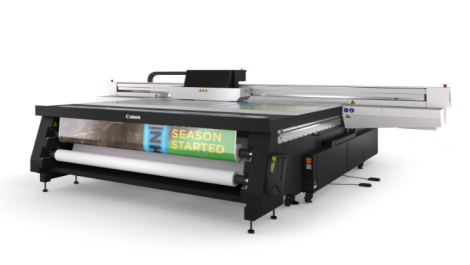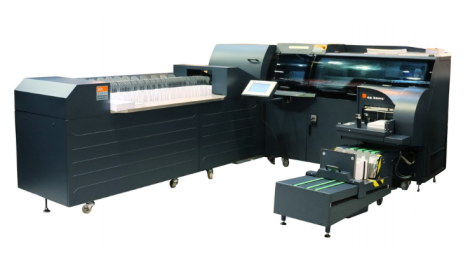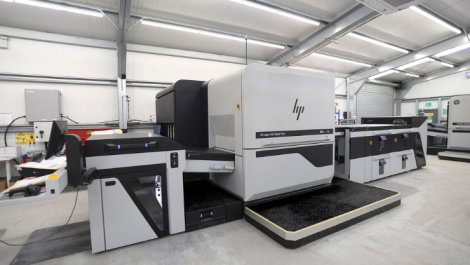Lawrence Dalton with his two partners Tony Anderson and Stuart Williams
Managing director of 1st Byte in London, ‘mad’ Tottenham supporter and movie buff, and winner of Digital Printer’s Supreme Award in 2012.
My father and grandfatherhad been in print so it was in my blood. I inherited a plate-making and typesetting company in the early 1970s, which I struggled for nearly 20 years to keep going. In the early 1990s there was a really bad depression and with that and the changes then happening in typesetting, I could not keep it going. I had to close a three-generation family business.
1st Byte was startedby my two partners, Tony Anderson and Stuart Williams, and I in 1996, with the aim of offering colour print in 24 hours – a much faster turnaround than was conventional back then. The only way to achieve that was by using what was then a very new technology – digital print. There were literally two options then: Indigo sheetfed or the Xeikon, which was web fed. Each had benefits but we decided to go down the Indigo route, mainly because the Indigo tests we ran proved to be more litho-like. The prime sell was on speed of turnaround and cost on short runs.
We found very quicklythat digital printing was quite difficult. The technology was far from robust. The quality was significantly poorer, particularly if flat tints or spot colours were required. Many clients would flatly refuse the end result. The quick turnaround was a major enough factor to keep us going until stage two, which was in 2000, when Indigo launched their second generation press, the UltraStream. For the first time this produced quality that was approaching litho.
We grew quite rapidly, and focused quite a lot on the finishing aspect of print. We would put work out, and find that the finishing house would close down for Friday afternoon, when our clients needed delivery. We decided to encompass every part of the printing process in-house. Our aim is still to offer one of the fastest services for colour printing.
One problem with Indigo has been the lack of a B2 engine, and in 2001 we ordered a Xeikon press which gave us a B2 sheet. We are on our second Xeikon press now. We have had 13 Indigos, and in our minds, and the majority of minds, the HP Indigo with its unique inking system still gives a result closer to litho reproduction than any other digital press.
We’ve only got two HP Indigos here at the moment, but they are the new 7600, which is nearly twice the speed of the HP Indigo 5000s that we had before. To me the 7600 is probably one of the most revolutionary presses that HP Indigo has brought out. Fundamentally we bought it because it gave us greater speed and a cheaper click rate. There is some improvement in quality, but there’s also a range of special effects on the 7600 that we really liked the look of.
In the last two years we have moved into a more creative printing environment than before, by which I mean high end, bespoke documents, mostly pitch or presentation documents. This includes case making, presentation boxes and slip cases. Those type of clients like the idea of foiling, embossing/ debossing and other effects on their product. The 7600 has also allowed us to print on heavier substrates (up to 500 microns); it gives us the ability to print white ink, to print clear ink like a watermark, to print raised ink, similar to traditional thermography, and to print onto a wider range of stocks than ever before, even onto black stocks.
The special effects that the 7600 can provide are central to our discussions with customers now. It allows us to sell a quality product to clients that are more interested in creating the right impression with their customers, than just wanting the cheapest price for 200 brochures. The HP Indigo 7600 press has also made us more competitive on regular work. We welcome the creative challenges that clients give us. To me, one of the great things about these special effects is that while white ink is nothing new, and clear ink is not terribly new, with the 7600 it means we can now achieve white ink printing and clear ink printing with CMYK in one hit at much lower cost than is conventionally possible for short runs. I see it as our role to get into the minds of designers who would not otherwise consider white ink because they think it will mean lots of overs, different processes and lots of time.
We are looking to host monthly seminars, having 40 to 50 people, designers primarily, and inviting speakers from HP to talk about innovations, and paper merchants to talk about innovations in digital papers and effects. We will finish off with my creative team explaining some of the new things we can offer and how designers can get the best out of them.
Innovation is very important. You have to be constantly looking at new ways of changing the product. Every day it gets more competitive out there so it’s no good standing still. We have always aimed to be the fastest, so we try to innovate in service. Running a Saturday shift regularly, for example – lots of people say they do, but you call them on a Saturday afternoon and you just get the phone ringing. Ever since we started, we knew we had to bring something different to the table to make people decide to give us a go.
We have placed an order at drupa for a Benny Landa press, a sheetfed B2 format press. I particularly liked the footprint of the Landa machine. It’s certainly significantly smaller than the HP Indigo 10000. Obviously there are big questions, and we will not buy the press until we can see the quality is as good as the HP is, because you never want to go backwards. We are in contact with them and there are discussions about a beta going out next year. I’m not too sure that even next year we will be at a stage where we are confident enough to move ahead with it.
To me Landa has three main sales points, and if he gets all three right, it will significantly change the print industry. If he gets two right, he will have great success; and if he gets one right he will just do okay.
First, he is selling a digital press running at litho speed. That’s the least interesting part to us as we would be hard pushed to fill the machine with print runs that, as a rule, are in the hundreds, not thousands. Second, the running cost is stated to reduce to below standard rates in the digital print industry, and that will have a major impact. Litho runs will be five thousand plus, and anything below will be digital – that will be the nail in the coffin for some litho companies. And third, the quality issue – nanography will give a more vibrant reproduction than current digital technology.
The speed issue he may be able to address. Cost, I think he can probably under-cut other people on that. It is the quality that I have to say I have the biggest concern in my mind about, and without the quality, it is very unlikely that we will be interested in taking up our order.
I have known Benny Landa since the very early days though. He called us in our second year of operation to ask how we were achieving the quantities of ink we were buying, having only started the previous year. We became Indigo’s second biggest user of ink in Europe in our second year. All three of us had our houses on the line, so we had a big incentive to make sure the press was running all the time!
We were as focused a small start-up company as you will ever find. It’s still the three of us running 1st Byte – we are here all the time and we get involved in every part of the process. We’ve all gone grey or lost all our hair in the intervening years though!





